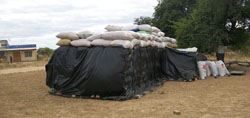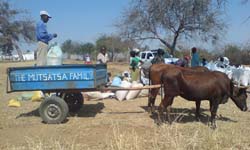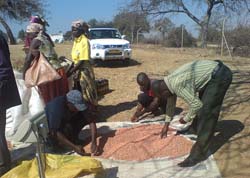The focus of the N2Africa project is to put nitrogen fixation into use for smallholder farmers in Africa. In Zimbabwe, the project has been running for two seasons and is now entering its third and final season. The farmers have gained some commendable knowledge and have benefitted from the technologies. These include the use and the importance of the inoculants, methods recommended for intercropping, the best inter-row and in-row spacing and also the use of manures and appropriate fertiliser rates. The use of improved varieties has enhanced the farmers’ seed selection base. Above all, the farmers have become aware of the challenges they meet when marketing their produce from these leguminous crops.This is mainly so in the districts where a larger area has been planted with some of these legume crops with the intention of selling.
In the last season farmers in Mudzi planted large areas of groundnuts and got good yields in the region of 1.5 – 2.0 tonnes per hectare. The varieties grown were Natal Common and Ilanda. During the marketing season, companies that buy the produce, for example the Grain Marketing Board, Agricom and Agriseeds went to the district at various shopping centres where they would ask the farmers to come and sell their produce to them. However, it turned out that these buyers were looking for specific varieties of groundnuts to be processed into peanut butter. These are the small seeded varieties such as Natal Common, which they were saying will produce peanut butter with a uniform pouring consistency, and are homogeneous in the whole container unlike the other varieties which would produce poor quality peanut butter. The latter were said to produce a peanut butter which would settle at the bottom of the peanut butter jars with a lot of oil at the surface. These will therefore be difficult to use because of the texture and it is not liked by consumers. This type of groundnut variety is meant for the roasted salt peanuts as a snack and therefore could not easily sell and this posed as a marketing problem for the farmers who had produced this variety of groundnuts in large quantities.
|
People attending a groundnuts field day on one farmer’s field in Mudzi |
A pile of groundnut bags ready for the market at Kanyoka business centre in Mudzi district |
In the same season in Guruve district there was an issue of sugar beans that were grown on a larger area and also attained very good yields of about 2 tonnes per hectare. The Cardinal variety gave some problems during the marketing period. The buyers were citing reasons which make the variety unpopular with most buyers and consumers such as low protein content compared to other available bean varieties, takes long to cook, taste not favourable and not appealing on the plate.
A farmer cited places where she had gone to look for a market for her crop and they declined to buy her produce. Farmers were also highlighting the dishonesty of the buyers especially in Guruve where the preferred variety that was first bought was Speckled Ice and those who had grown Cardinal had to sell the crop at a lower price. The buyers, after realising that all the Speckled Ice variety was bought, then came to farmers and bought Cardinal at a much higher price. The rationale used by the buyers was that they knew that most farmers had grown more of Cardinal and they wanted to capitalise on farmers by reducing the demand of the variety, offering a very low price saying that the crop was low in demand from the public. The preferred varieties were white seeded varieties like Speckled Ice and Bonus which the buyers came and bought at a much higher price than the Cardinal.
|
Here farmers are bringing their produce to the central collection point- notable absence of infrastructure for storage (Picture by Byron Zamasiya) |
Farmers grading their groundnuts before weighing the produce and taking it to be marketed (picture Byron Zamasiya) |
From the last season experience, it could be noted that farmers now know the demands of markets and are making some frantic efforts to source the legume varieties that provide high yields and at the same time can be sold without any difficulties. From another point of view, it showed that there is an information gap between the farmers and the market on prices, hence the problems with the buyers of the produce.
It is very important that farmers look for market demands before they grow their crops, so that at the end of the season they will not lose their produce to unscrupulous dealers at the end of the season.
Isaac Chabata and Caroline Chipomho




